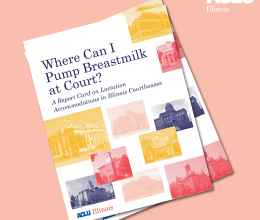
Illinois law requires that county courthouses across the state have a private lactation room or area outside of the bathroom for members of the public to express breast milk. But simply designating a space for lactation is meaningless if members of the public cannot access that space when they need it. We have compiled a checklist of best practices that courthouses should follow to ensure that their policies and practices regarding lactation space access for members of the public are workable and effective.
- Identify specific private room(s), located outside of a restroom, available to lactating persons for pumping and/or nursing, containing at a minimum a chair, a table, and an electrical outlet.
- If a room may accommodate multiple users at one time, the number of electrical outlets should equal the maximum number of potential users of the room.
- Whenever possible, the room should also include a sink with running water. If not available within the lactation room itself, a source of running water should be accessible in close proximity to the lactation room.
- Provide ample signage throughout the building making lactating persons aware of the lactation space and the procedure for gaining access.
- Signage should not be limited to the vicinity of restroom facilities; it should be visible in each part of the building that is regularly visited by members of the public, such as the entryway, lobby area, and outside every elevator.
- Provide information on the courthouse’s website regarding the lactation space and the procedure for gaining access, which is easily navigable from the main page of the website.
- Identify specific employee(s) charged with managing timely access to the lactation space.
- The individual(s) charged with managing access to the lactation space should be easily accessible in person to any member of the public who seeks to gain access to the space. The individual(s) should have the ability to provide access directly to the lactation room(s) via a key, swipe card, keypad code, or other mechanism. If a single employee is identified as the primary point of contact for accessing the lactation space, a back up option if this primary employee is unavailable should be identified.
- Any individual(s) charged with managing access to the lactation space should receive basic training about the purpose and proper functioning of a lactation space.
- If there is a procedure for members of the public visiting the courthouse to reserve access to a lactation room ahead of time by contacting the individual(s) charged with managing access to the space, use of this procedure should be optional. Timely access to lactation space must also be assured to any member of the public who seeks it when already present at the courthouse.
- Ensure room(s) can be locked and unlocked from the inside as well as the outside.
- There should be a mechanism for identifying when a room is already in use in order to protect the privacy of lactating persons. In addition, if it will be possible for a room to be unlocked from the outside while already in use, there should be a curtain, partition or other method available to shield any users who are in the room
- Provide a sufficient amount of lactation space for the number of individuals present in the building and/or office who may need to access it.
- The Office on Women’s Health recommends a formula for determining the number of lactation spaces that should be provided by employers to meet the needs of employees. This formula can be adapted to the courthouse depending on the typical volume of public traffic in the building, as well as whether the room is designated just for members of the public or is also available for use by employees.
- Sufficient lactation space may be provided by multiple rooms that are each separately lockable or by one or more lockable multi-user rooms. If there is a multi-user lactation room that may be accessed by more than one lactating person at one time, there must be curtains, partitions, or another mechanism that adequately secures privacy for each individual user.
- Provide signage within each lactation room that provides contact information for the courthouse employee(s) that users can contact about any issues with the room.
- Provide training to all personnel about the location and procedure for accessing the lactation space, so that they may properly respond to inquiries from any members of the public.
- Authorize personnel who regularly interact with members of the public having business with the court – including, but not limited to, jurors, litigants, attorneys, and witnesses – to provide access for a lactating person to any appropriate alternative non-restroom space if an identified lactation room is not readily available to the lactating person upon their request.





